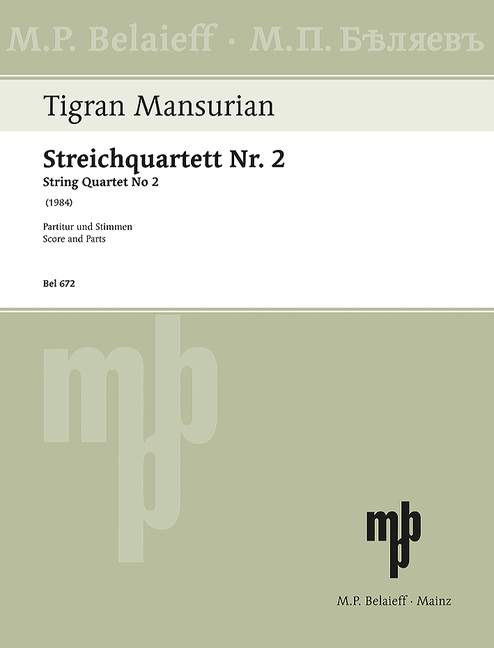Mansurian: String Quartet No. 2
Expected to ship in 1-2 weeks.
- Composer: Tigran Mansurian (1937-)
- Format: Score & Set of Parts
- Instrumentation: String Quartet (Violin I, Violin II, Viola, Cello)
- Work: String Quartet No. 2
- ISMN:
- Size: 9.1 x 11.9 inches
- Pages: 84
Description
After I had dedicated my first quartet (1983, No. 84) to the memory of a friend and musician who died young, I had to mourn the death of yet another friend: Eduard Khagagortyan. To him, I dedicated my second quartet. in Armenia, the song "It is spring… It is snowing…", written by the great composer of Armenian music Komitas (1869-1935), is very popular. It is characterized by an elegiac melody. When composing the quartet, I was influenced by some tones of the piano accompaniment. Furthermore, I was inspired by modulations from the treasury of songs of Armenian medieval sacred music. They are based on hymn-like poems and contain philosophical thoughts. with regard to the end of the quartet, I would like to paint a little picture: A churchyard. The day draws to a close. It gets dark. A group of clergymen dressed in black slowly crosses the churchyard and disappears into the dark at the back. in my imagination, this quiet and slow procession represents the transition from partial darkness to total blackness; it is also a mystic picture of death – very impressive. These pictures and colors determine the end of the second quartet. The pizzicato of the four strings represents a chorale that unfolds, yet has not enough strength to become a real chant. Its color is black too. (Tigran Mansurian) Without any frills and effects, without melancholy and monotony, in a mainly moderate tempo, literally simple and moving, impressive without trying to impress – this is how Mansurian's music unfolds: like a small plant that tries hard to grow and sprouts leaves even though there is hardly any light and the soil provides only few nutrients, or as if the musicians are engrossed in a conversation while it remains unclear which direction it takes.
Publishers use a lot of words to describe what they sell, and we know it can be confusing. We've tried to be as clear as possible to make sure you get exactly what you are looking for. Below are descriptions of the terms that we use to describe the various formats that music often comes in.
Choral Score
A score for vocalists that only contains the vocal lines. The instrumental parts are not there for reference. Generally, cheaper than a vocal score and requires multiple copies for purchase.
Facsimile
Reproductions of the original hand-written scores from the composer.
Full Score
For ensemble music, this indicates that the edition contains all parts on a single system (there are not separate parts for each player). In larger ensembles, this is for the conductor.
Hardcover
Hardbound. Generally either linen-covered or half-leather.
Orchestral Parts
Similar to a wind set, this is a collection of parts. In the case of strings, the numbers listed are the number of copies included, though generally these are available individually (often with minimum quantities required).
Paperback
When publishers offer multiple bindings (e.g. hardcover) or study scores, this is the "standard" version. If you're planning to play the music, this is probably what you want.
Performance / Playing Score
A score of the music containing all parts on one system, intended for players to share. There are not separate parts for each player.
Set of Parts
For ensemble music, this indicates that there are separate individual parts for each player.
Solo Part with Piano Reduction
For solo pieces with orchestra, this is a version that contains a piano reduction of the orchestra parts. For piano pieces, two copies are typically needed for performance.
Study Score
A small (think choral size) copy of the complete score meant for studying, and not playing. They make great add-ons when learning concertos and small chamber works.
Vocal Score
A score prepared for vocalists that includes the piano/organ part or a reduction of the instrumental parts.
Wind Set
For orchestral music, this is a collection of wind and percussion parts. The specific quantities of each instrument are notated.
With Audio
In addition to the printed music, the edition contains recordings of the pieces. This may be an included CD, or access to files on the internet.
With / Without Fingering (Markings)
Some publishers prepare two copies - a pure Urtext edition that includes no fingering (or bowing) suggestions and a lightly edited version that includes a minimal number of editorial markings.


